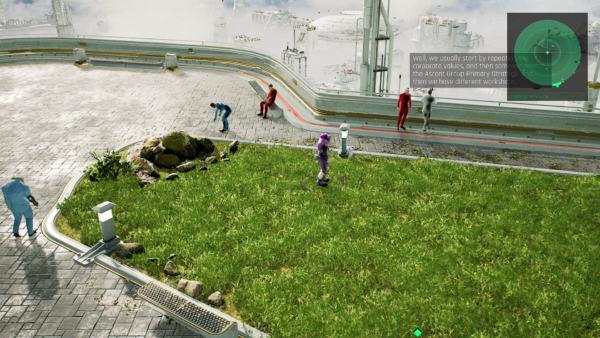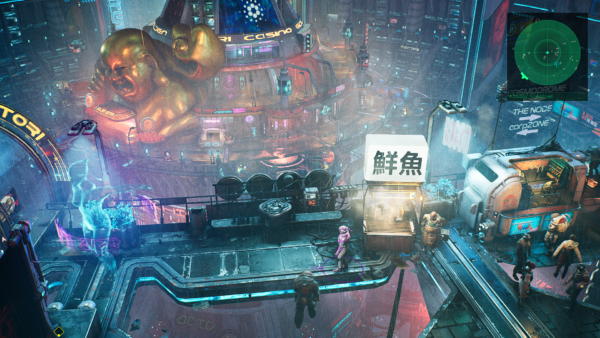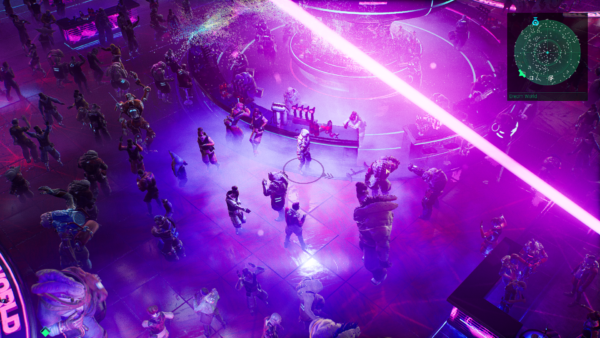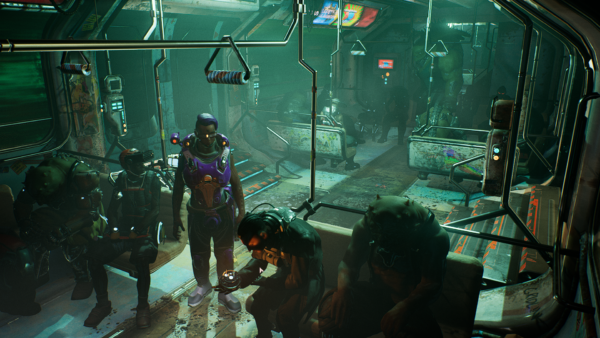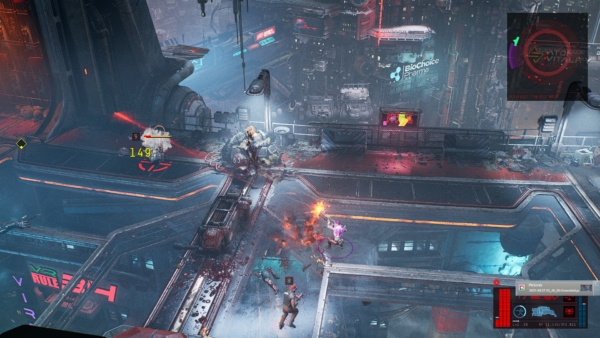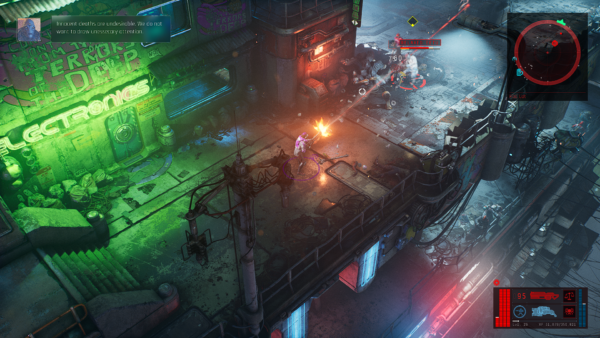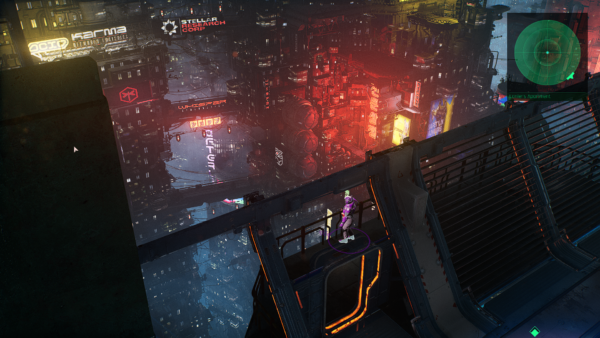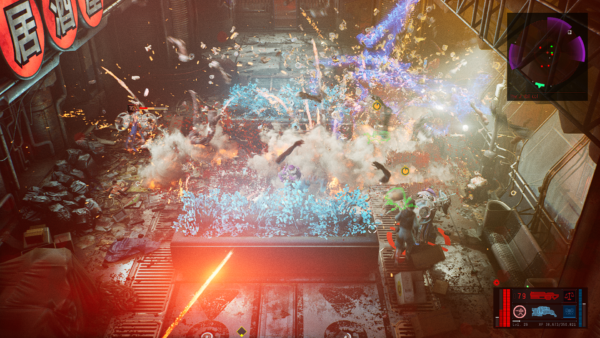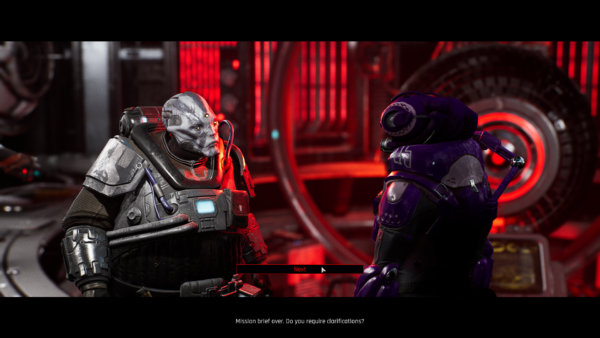What looks like Cyberpunk 2077, plays like Diablo and Torchlight, and is developed by an indie studio?
Introducing The Ascent, a role-playing action game developed by a 12-person team at Neon Giant.
It’s hard not to draw parallels to Cyberpunk 2077 since the re-imagining of the cyberpunk world is so firmly entrenched by popular culture, with influence from books by William Gibson and Philip K. Dick, as well as movies like Bladerunner and Ghost in the Shell.
In terms of setting, there are some similarities to Cyberpunk 2077, such as evil mega-corporations enslaving all beings, the inequitable income divide between the haves and the have-nots, pricey augmentations that bestow special abilities, and the pervasive gaudy neon-lit signs and advertisements that give your eyes no respite.
The gameplay, however, is drastically different. The Ascent plays as an intense real-time action role-playing game in an isometric perspective, so it’s similar to Diablo and Torchlight but with a cyberpunk feel.
Instead of swords and sorcery, you have guns and cybernetic augmentations to deal with fast-moving enemies that tend to swarm around you.
Who’s the boss?
You play a lowly indentured worker in the planet of Veles at a multi-level Arcology where there is a clear demarcation of the haves and have-nots.
The wealthy corporate employees hang out at the clean and gleaming level up high with blue skies and green grass, while the indentured workers are stuck at the dim and slummy clusters down below, where many like you are working their lives away, trying to pay off their massive space travel debt to greedy mega-corporations.

Where the high SES people hang out – blue skies, green grass and gleaming buildings. The different environments between the rich and poor in The Ascent are worlds apart. SCREENSHOT: Yap Hui Bin
The story begins when the most dominant corporation, The Ascent Group, collapses and starts a chain reaction of hostile takeovers, turf wars and job insecurity for the workers. The main questline sends you off to find out the truth behind the events leading to The Ascent Group’s downfall while helping other characters along the way.
Although the story starts off with showing a lot of potential, somehow it seems to lose its way as the game progresses without a strong coherent storyline.
There are no options to choose whom you want to fight for, so there isn’t any attachment to any character in the game, and you just end up fighting for whomever is calling the shots at the moment. I feel like a disengaged employee with no loyalty and who is simply following orders of the boss of the day.
The Ascent’s role-playing element comes in the form of customising your character’s gender and appearance although these choices are purely cosmetic, since your character doesn’t speak and everyone eventually looks the same with armour on.
As your character progresses, you can invest Skill Points to upgrade your skills and attributes from level 0 to 20 to suit your style of gameplay.
The world of The Ascent is diverse with various humanoid and alien species that coexist with humans. This makes for interesting conversations with the different species that you encounter, as well as the topics of “speciesism”. Your character, as a Sapien, is frequently looked down on by the other species.

The Ascent’s diverse community and bustling streets with chatty NPCs make exploration enjoyable. SCREENSHOT: Yap Hui Bin
What I like about the game is that it’s light-hearted and doesn’t take itself too seriously, and also doesn’t harp on the tragedy of being an indentured worker.
The interesting and off-beat Non-player Characters (NPCs) you meet and talk to vary. Some are accepting of their fate, with witty, matter-of-fact perspectives despite their miserable lives, while others can be insulting and demeaning towards your character, or are purely mercenary and self-serving without remorse.
Corporate challenge
With a dozen main story missions and a bunch of side quests, The Ascent offers plenty of opportunity to explore the many tiers and distinct districts of the Arcology.
There are the Warrens in the messy, filthy and gloomy lower level where most of the indentured workers reside, the High Street level with its fancy clubs and casinos, and the uppermost Pinnacle level that is with lovely views for employees of the mega-corporations.

There’s never a dull moment in The Ascent, with glitzy clubs to party in and casinos to lose money in. SCREENSHOT: Yap Hui Bin
I enjoy meeting the quest givers as well as the side quests they send you off to perform in order to gain precious experience points (XP) and money in the form of uCreds. Most of them are fetch quests but they are often ingeniously disguised to seem a lot more interesting.
For instance, one character requests that you collect bath water from a bath house frequented by a certain species to be sold as a premium beverage (eww!), and another requires cameras to be planted in different places for him to enjoy the view as he is afraid to travel.
Unfortunately, my enjoyment of the side quests are marred by several poor design elements that make them very frustrating to complete.
The waypoints on the map that point to the location of the quests sometimes do not show up, and can be confusing and inaccurate, which makes finding the location of the mission very difficult.
Another problem is the recommended level for quests as well as the prerequisites for completing are misleading. There were times I ended up fighting through hordes of tough enemies for a seemingly low-level quest.
In actual fact, the area was not accessible until I completed a higher level main quest, which meant I had to return later and work through the hordes again.
For instance, one of the side quests labelled level 5 is for a location that isn’t accessible until a main quest at level 17 is completed, which is incredibly frustrating especially since I had risked life and limb to get there.

Mind the gap! The Ascent offers great fast travel options like the Metro as well as the expensive but convenient taxis. SCREENSHOT: Yap Hui Bin
With all the running around the different levels and areas around the Arcology, The Ascent offers some good fast travel options, but only within the same level of the Arcology. These are a Metro system as well as a taxi pickup service for those with deeper pockets.
For 1,000 uCreds, the taxi offers a lot more destinations and can pick you up in most places except building interiors or places with no space to land.
Taxis offer a safe way to get from place to place, especially if your character doesn’t have enough health to survive another ambush.
The 1,000 uCreds are nothing later in the game when loads of money can be earned with not so many places to spend them.
Be warned that there are no “town portals” that let you return to the exact place in the dungeons, so if you opt to bail out of a boss fight deep in the dungeon, it means having to fight through all the levels again to get back to the boss.
I did get stuck at some of the boss battles and had to abandon the fight to go back to town to upgrade my gear using the very useful taxi service.
But thankfully, unlike in Diablo, you don’t drop your precious loot when you die, so you are not disadvantaged in clearing the dungeon again nor having to worry about grabbing your loot right in the face of a boss.
Office politics
With gameplay that is somewhat like a cyberpunk version of Diablo that involves shooting with guns, fast and accurate aiming is critical for fast-paced combat where you are frequently outnumbered and outpaced.
The game’s isometric top-down fixed view makes aiming with a controller’s thumbsticks really difficult, and I found playing with a mouse so much easier, so I switched from the Xbox controller to playing with a mouse and keyboard instead.

Crouching behind cover adds a tactical aspect in frenetic battles. SCREENSHOT: Yap Hui Bin
The Ascent offers another level of tactical gameplay in that you can, and should, take cover while shooting. Shooting behind cover and avoiding damage is the best way to survive the many waves of enemies that the game unleashes upon you.
Also, fighting in the streets happens quite often, so it is difficult to avoid harming innocent bystanders. I usually try to fire a warning shot before taking on the enemies, which will cause a hilarious stampede among the fleeing crowd who will be screaming in fear or yelling “Ahh! A crazy person!”.
As there are no melee weapons in The Ascent, avoiding close quarter combat fighting and being forced in a corner is key.
This is where the right augmentations can help. Certain augmentations can help push the hordes away, or let you evade the crowds, or grant health bonuses.
My augmentation of choice is unleashing kamikaze spiderbots that can really help to clear the room. But all augmentations require some cooldown time and energy recharging, so timing their use can make a difference between life and death.
Another tactical aspect to combat is the weapons selection for dealing with the different types of enemies, and you need to pick the most damaging ones against the particular foe.
For example, robot enemies are weaker against weapons dealing electrical damage, human enemies are weaker against fire, and big mecha-suited enemies suffer most from rockets and missiles. I find myself switching the weapon loadout quite often depending on the situation.
This is especially so for boss battles that require upgraded weapons, pricey armour and abilities to beat. If you are hoping to use the run-and-gun tactic a lot, be warned that running too far away from the bosses can give them an opportunity to heal up.

Fighting often takes place on the streets, which means collateral damage is unavoidable. A warning shot can cause the crowd to flee but it will also alert the enemies. SCREENSHOT: Yap Hui Bin
Return on investment
The Ascent offers a good selection of loot in the form of weapons, armour as well as cybernetic augmentations that can be picked up from slain enemies or purchased from merchants.
Gear choice and weapon upgrading is critical in surviving the enemy encounters in the arcology as well as the boss battles.
I found the earlier part of the game very challenging when the really good weapons and armour are out of reach, but things get better as you get access to better weapons and armour.
The Ascent’s fabulous arsenal include hand cannons, shotguns, rifles, miniguns and rocket launchers. Each weapon type varies in terms of reload time, clip size and the type of damage they do.
Weapons can be upgraded to increase their Mk levels from 1 to 10 that increases the damage dealt to your enemies.
This requires components that can be found scattered around the map or dropped by enemies. With three tiers of components – Basic, Advanced, and Superior – to upgrade weapons, this means you have to be very careful when choosing which weapons to upgrade to the maximum Mk 10 level.
In particular, advanced components are scarce. This means you have to be very sure to select the right weapons to upgrade, otherwise some of the later bosses can be very hard to beat!

Through a scanner darkly – The Ascent’s cyberpunk world is incredibly detailed and so much fun to explore. SCREENSHOT: Yap Hui Bin
I wish there was a way to re-spec the weapons and salvage the components, even if it means using a lot of money since uCreds are easy to come by later in the game.
On the other hand, armour cannot be upgraded, so it’s a matter of finding or buying the ones that offer the best protection against the enemies that you are facing at the moment. There’s really no reason to be stingy with uCreds – just buy the best armour available!
The Ascent’s simplified loot system is pretty effective and hassle-free. You don’t have to worry about picking up or acquiring the different types of ammo – all weapons come with unlimited ammunition.
Weapons acquired are basic model without complex variants and attributes. Once upgraded, all units of the same model will remain upgraded without having to worry about the specs of each individual weapon, so inventory management is very straightforward.
Unfortunately, loot hoarders who love finding legendary or rare weapons won’t be satisfied by this simplified loot system.
Other forms of loot include uCreds, health kits and vials for restoring energy levels hidden in crates, containers, lockers and even vehicles.
There are also vending machines that can restore health, energy and tactical charge levels at a price and in limited supply. These can help your character survive the battles as well as use augmentations and tactical weapons, so it’s always good to scout the area before starting a big battle.
Audio visual aids
Don’t let the idea of an isometric perspective put you off – The Ascent is a very good looking game with realistic lighting and ray tracing effects, as well as high quality cinematic cutscenes.
The cyberpunk world as well as the different levels of the Arcology are well designed and look really distinct, with intricate details to appreciate. When it is raining on the High Street level, you can see raindrops on umbrellas held up by pedestrians and signboards reflected off the puddles.
The Arcology is a joy to explore with its many levels of elevation, although this also contributes to some difficulty in wayfinding.
Even though combat is very fast paced, there are details to appreciate during the frenetic action. You can see body or machine parts flying around when you decimate your foes, explosive barrels spewing fire, and vending machines or containers falling apart when caught in the cross-fire.

Things that go ka-boom – The Ascent offers augmentations that serve up spectacular and satisfying destruction. SCREENSHOT: Yap Hui Bin
In terms of audio, apart from some initial bugs, the developers have done a commendable job with the music and voices.
The Ascent’s electronic music sets the mood of exploring a cyberpunk-themed world, with the main theme carrying a hint of influence from the music of Ghost in the Shell.
I also like the music changing depending on the situation you are in, such as fast-paced music during combat which will fade out once you are “safe”. There are also nice touches like a “muzak” version of the main theme heard during elevator rides.
Although our character doesn’t speak, the dialogue with NPCs is quite engaging, even though not all speak the Sapien language.
You can also eavesdrop on others having conversations that correspond with the actions you have taken in the main storyline, which makes walking around and being a “kay poh” (meaning a nosey parker or busybody in Hokkien) very enjoyable. If you love interacting with characters in open-world games, this is a big plus.
With its intense violence with rampant (and satisfying) dismemberment and blood, copious swearing and simulated gambling, The Ascent is suitable for adults 18 years old and above.
You can also play with others through co-op online with up to four others, or co-op on the couch with another person. Cross-platform play is also available for PC and Xbox.
The Ascent has a fair share of bugs in the early days of its release – I had experienced the game freezing and stuttering quite a bit, as well as being stuck on the spot during the first week of playing.
There were also irritating audio bugs like sudden loud screeching sounds from a flying drone that made me jump. To the developers’ credit, they have been aggressively patching the game since its release, so the game is a lot more stable and enjoyable of late.

The Ascent’s detailed graphics, beautiful lighting effects and lovely cinematic cutscenes are a joy to behold. SCREENSHOT: Yap Hui Bin
TL;DR
Best described as a cyberpunk Diablo action role-playing game, The Ascent features enjoyable gameplay, detailed graphics and clever map design.
The fast-paced and intense combat balanced with amusing side quests and ample opportunity for exploration makes The Ascent very addictive. Considering that it was developed by an indie studio of 12 people, this is still an accomplishment.
However, the poor design for side-quest management, weak story and high incidence of bugs mar an otherwise great game.
You can currently play it for free if you are subscribed on the Xbox Game Pass; otherwise, it costs S$40 on Xbox Store (without the 20% Game Pass discount), or S$36 on Steam. For the price, the game comes with a huge and enjoyable world to explore and is well worth the investment.
